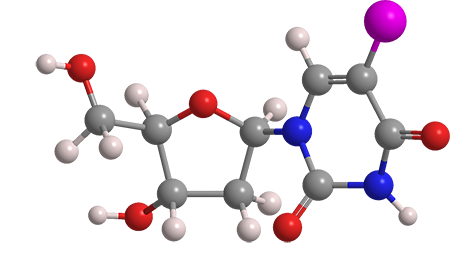What molecule am I?


Idoxuridine is an iodinated analogue of the nucleosides deoxyuridine and thymidine. It was first synthesized by William H. Prusoff at Yale University (New Haven, CT) in 1958. Five years later, it became the first antiviral drug approved by the US Food and Drug Administration, for topical use against herpes simplex keratitis.
Idoxuridine in solution or ointment form also has ophthalmic applications. It cannot be administered internally because it is cardiotoxic.
If idoxuridine is the oldest antiviral, what is the newest? One candidate is lufotrelvir1, a compound disclosed in 2020 by researchers at multiple laboratories of Pfizer Worldwide Research and Development and other institutions. Lufotrelvir is a potential treatment for COVID-19, although, unlike some others, it must be administered intravenously. This month, Robert A. Singer and co-workers at Pfizer (Groton, CT) reported an improved synthesis of the relatively unstable lufotrelvir.
1. CAS Reg. No. 2468015-78-1.
Idoxuridine hazard information*
| Hazard class** | GHS code and hazard statement | |
|---|---|---|
| Acute toxicity, oral, category 4 | H302—Harmful if swallowed | |
| Acute toxicity, dermal, category 4 | H312—Harmful in contact with skin | |
| Skin corrosion/irritation, category 2 | H315—Causes skin irritation | |
| Serious eye damage/eye irritation, category 2A | H319—Causes serious eye irritation | |
| Acute toxicity, inhalation, category 4 | H332—Harmful if inhaled | |
| Specific target organ toxicity, single exposure, respiratory tract irritation, category 3 | H335—May cause respiratory irritation | |
| Germ cell mutagenicity, category 2 | H341—Suspected of causing genetic defects | |
| Reproductive toxicity, category 2 | H361—Suspected of damaging fertility or the unborn child | |
*Compilation of multiple safety data sheets.
**Globally Harmonized System (GHS) of Classification and Labeling of Chemicals. Explanation of pictograms.
Molecules from the journals
2,3,5-Trimethylpyrazine1 is a widely used synthetic flavor and aroma additive for foods. Described as imparting nutty, earthy, or “roasty” characteristics, it is used for enhancing coffee, chocolate products, and cereals, among others. This past November, Roman Lang and co-workers at Technical University Munich (Freising, Germany) described an analytical method for determining 2,3,5-trimethylpyrazine metabolites in human urine.
Obeticholic acid2 (6α-ethylchenodeoxycholic acid) is a first-in-class farnesoid ester X receptor agonist used to treat primary biliary cirrhosis and nonalcoholic steatohepatitis. It was developed by Intercept Pharma (Morristown, NJ) and approved by the US Food and Drug Administration in 2016 under the tradename Ocaliva. In November, Vijayavitthal T. Mathad and colleagues at MSN Laboratories (Hyderabad, India) reported an efficient synthesis of obeticholic acid that minimizes process-related and diastereomeric impurities.
Europium(III) oxide3 (Eu2O3) is widely used as a color-producing phosphor in television screens and as a fluorescent component in glassware; it is also used in paper currency for counterfeit detection. But Eu2O3 and other lanthanide oxides are also constituents of radioactive nuclear waste that must be separated from actinide oxides during waste treatment. In December, Prasanta Kumar Mohapatra and co-workers at Bhabha Atomic Research Center (Mumbai, India) identified an ionic liquid that can be used to separate Eu2O3 from americium and uranium oxides in a liquid–liquid extraction process under ambient conditions. The actinide oxides are poorly soluble in the ionic liquid.
1. CAS Reg. No. 14667-55-1.
2. CAS Reg. No. 459789-99-2.
3. CAS Reg. No. 1308-96-9.
Molecules from the Journals
MOTW briefly describes noteworthy molecules that appeared in recent ACS journal articles. See this week's
edition below.
Idoxuridine fast facts
| CAS Reg. No. | 54-42-2 |
| SciFinder nomenclature | Uridine, 2′-deoxy-5-iodo- |
| Empirical formula | C9H11IN2O5 |
| Molar mass | 354.10 g/mol |
| Appearance | White crystals or powder |
| Melting point | Values reported from 170 to 263 °C |
| Water solubility | 2 g/L |

Learn more about this molecule from CAS, the most authoritative and comprehensive source for chemical information.
Molecule of the Week needs your suggestions!
If your favorite molecule is not in our archive, please send us a message. The molecule can be notable for its current or historical importance or for any quirky reason. Thank you!
Stay Ahead of the Chemistry Curve
Learn how ACS can help you stay ahead in the world of chemistry.

